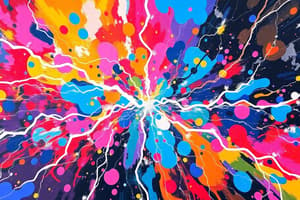Podcast
Questions and Answers
What is static electricity?
What is static electricity?
- Stationary electricity resulting from the interaction of charged particles (correct)
- Electricity generated by movement of charged particles
- Electricity created by the transfer of protons
- Electricity produced by the flow of electrons
Which method of charging involves the transfer of electrons between objects?
Which method of charging involves the transfer of electrons between objects?
- Charging by Friction (correct)
- Charging by Conduction
- Charging by Induction
- Charging by Contact
According to the BohrRutherford model of the atom, what happens when an object has an excess of electrons?
According to the BohrRutherford model of the atom, what happens when an object has an excess of electrons?
- The object has a positive charge
- The object loses its electrons
- The object has a negative charge (correct)
- The object becomes neutral
What results from an object with a deficit of electrons?
What results from an object with a deficit of electrons?
Which type of material can hold on to electrons more effectively?
Which type of material can hold on to electrons more effectively?
What is the BohrRutherford model of the atom used to explain?
What is the BohrRutherford model of the atom used to explain?
Which method of charging involves the redistribution of electrons without direct contact?
Which method of charging involves the redistribution of electrons without direct contact?
What type of charge does an object with an excess of electrons have compared to a neutral object?
What type of charge does an object with an excess of electrons have compared to a neutral object?
What type of energy results from the interaction of charged particles?
What type of energy results from the interaction of charged particles?
What conclusion does the BohrRutherford model of the atom draw about the creation or destruction of electrically charged particles?
What conclusion does the BohrRutherford model of the atom draw about the creation or destruction of electrically charged particles?
Flashcards are hidden until you start studying




